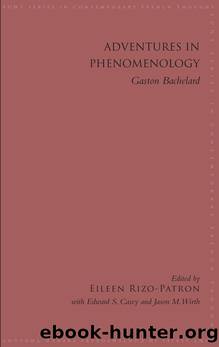Adventures in Phenomenology by unknow

Author:unknow
Language: eng
Format: epub
ISBN: 9781438466071
Publisher: SUNY Press
Published: 2017-07-15T05:00:00+00:00
Notes
1.Maurice de Gandillac, Henri Gouhier, and René Poirier, eds., Bachelard: Colloque de Cerisy (Paris: Union Générale dâÃditions, 1974), 284; my translation: âLes peintres dâaujourdâhui sont très convaincus que ce quâils font échappe aux mots. Personnellement, après une experience relativement longue, qui est allée de lâabstrait au concret, je crois que le discours, dâune certaine manière, peut très bien render compte aussi de lâimage, encore quâelle ne soit jamais épuisée par lui.â
2.Writing in 1951, Bachelard could not have foreseen the ubiquity of planetary âspeechâ made possible by the internet. But such phenomena as the World Wide Web simply enrich his original observation that we now all live in a logosphere.
3.Jacques Derrida, Of Grammatology, trans. Gayatri Chakravorty Spivak (1967; Baltimore: Johns Hopkins University Press, 1974), 3 (emphasis added); hereafter cited as G.
4.Jacques Derrida, Margins of Philosophy, trans. Alan Bass (1972; Chicago: University of Chicago Press, 1982), xii; hereafter cited as M.
5.Jacques Derrida, The Truth in Painting, trans. Geoff Bennington and Ian McLeod (1978; Chicago: University of Chicago Press, 1987), 2, 255; hereafter cited as TP.
6.See Martin Heidegger, âThe Origin of the Work of Art,â in Basic Writings, ed. David Farrell Krell (New York: Harper & Row, 1977), 143â87. See also Meyer Schapiro, âThe Still Life as a Personal Object: A Note on Heidegger and Van Gogh,â in The Reach of Mind: Essays in Memory of Kurt Goldstein, ed. Marianne L. Simmel (New York: Springer, 1968), 203â9.
7.Louis Marin has attempted to establish parallels between verbal and iconic techniques of communication. See his âToward a Theory of Reading in the Visual Arts: Poussinâs The Arcadian Shepherds,â in The Reader in the Text: Essays on Audience and Interpretation, ed. Susan R. Suleiman and Inge Grossman (Princeton: Princeton University Press, 1980), 293â324, and his âOn Reading Pictures: Poussinâs Letter on Manna,â Comparative Criticism 4 (1982): 3â18. Such âreadingsâ of visual art rely on the identification of structures drawn from language but common to each medium. Bachelard, on the other hand, clearly gives a privileged status to words themselves, that is, to semantic rather than semiotic elements, as the necessary means of imagining. As I have argued elsewhere, however, Bachelardâs determination to avoid technical, âlinearâ readings does not preclude or invalidate more conceptual methods, provided these are attempted separately and are not the initial means of approaching the work. See my essay âGaston Bachelard and Critical Discourse: The Philosopher of Science as Reader,â Stanford French Review 5 (1981): 217â28, and my revised and updated Gaston Bachelard, Philosopher of Science and Imagination (Albany: SUNY Press, 2016), 134â36.
Download
This site does not store any files on its server. We only index and link to content provided by other sites. Please contact the content providers to delete copyright contents if any and email us, we'll remove relevant links or contents immediately.
What's Done in Darkness by Kayla Perrin(25501)
Shot Through the Heart: DI Grace Fisher 2 by Isabelle Grey(18220)
Shot Through the Heart by Mercy Celeste(18160)
The Fifty Shades Trilogy & Grey by E L James(17776)
The 3rd Cycle of the Betrayed Series Collection: Extremely Controversial Historical Thrillers (Betrayed Series Boxed set) by McCray Carolyn(13189)
The Subtle Art of Not Giving a F*ck by Mark Manson(12912)
Scorched Earth by Nick Kyme(11833)
Stepbrother Stories 2 - 21 Taboo Story Collection (Brother Sister Stepbrother Stepsister Taboo Pseudo Incest Family Virgin Creampie Pregnant Forced Pregnancy Breeding) by Roxi Harding(11040)
Drei Generationen auf dem Jakobsweg by Stein Pia(10217)
Suna by Ziefle Pia(10186)
Scythe by Neal Shusterman(9263)
International Relations from the Global South; Worlds of Difference; First Edition by Arlene B. Tickner & Karen Smith(8609)
Successful Proposal Strategies for Small Businesses: Using Knowledge Management ot Win Govenment, Private Sector, and International Contracts 3rd Edition by Robert Frey(8419)
This is Going to Hurt by Adam Kay(7696)
Dirty Filthy Fix: A Fixed Trilogy Novella by Laurelin Paige(6453)
He Loves Me...KNOT by RC Boldt(5805)
How to Make Love to a Negro Without Getting Tired by Dany LaFerrière(5378)
Interdimensional Brothel by F4U(5304)
Thankful For Her by Alexa Riley(5162)
